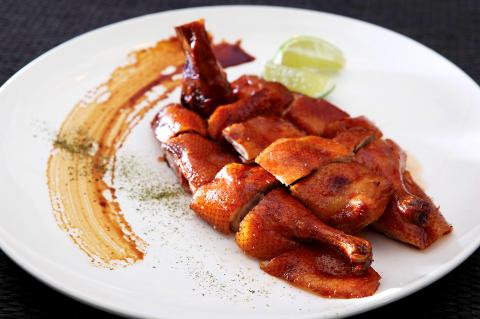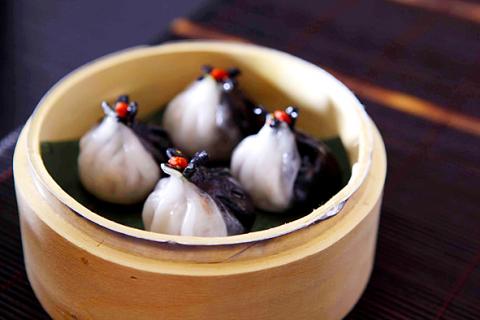The name of My Humble House Restaurant is ever so slightly disingenuous and self-satisfied, but false modesty is no sin, and this not so humble temple of “new Cantonese cuisine” has little it needs to be shy about. The first thing you notice as you run through the menu is that it has vast ambitions to span ancient heritage and modern culinary trends. Many dishes, from main meat dishes such as roast duck down to tiny little dumplings, seek to mediate classic techniques and flavors through an understanding of contemporary gastronomy and Western fine dining, providing guests with something unexpected at every turn.
The restaurant is located on the second floor of Le Meridien Hotel in Taipei’s swank East District. The decor, with its sleek minimalist finish and its luxurious black and red color scheme, might be described as “contemporary oriental luxury,” and while it has plenty of sophistication, it does not provide much in the way of surprises. It would not be out of place as a Chinese restaurant in any five-star international hotel.
But as stated above, the food is quite another matter. There are pleasant surprises at every turn. The roast duck is a fine example. This is a Cantonese dish that is boringly familiar to most regular visitors to Chinese restaurants, and it is often indifferently prepared. What particularly distinguished the dish at My Humble House Restaurant is the use of “cherry ducks” (宜蘭櫻桃鴨) from Yilan, a small but high quality bird with delicious meat. Served under the label of chef’s special spice marinated roasted duck (貝琵琶鴨仔, NT$1,500), the dish has many attractions. There is of course the contrast between the firm yet tender meat and the crisp skin, but the surprise was in the subtle flavors of the flesh, hinting at a wide range of Chinese medicinal herbs and spices but with the base note flavor of the duck never in danger of being overwhelmed. The neck, which is something of an acquired taste, and which is often removed, can be served separately on request. If you have the time, and the meal is not a formal one, there is nothing better than picking through the flavorsome morsels.

Photo courtesy of Le Meridien Taipei
With the roast duck, the surprise comes with the choice of bird which provides a vehicle for the chef’s skill. In other instances on the menu, the restaurant tries to offer attempts at various east-meets-west dishes. Its high level of success is due to a willingness to hold firm to authentic Cantonese techniques, so that dishes rarely if ever wander off into the mishmash of undefinable fusion cuisine found elsewhere. A fine example is the wok-fried beef with cilantro and goose liver (香根拌鵝肝和牛粒, NT$1,080), which is really nothing more than a beef stir-fry, but through the use of prime US beef and rich foie gras, the dish becomes something unique, while remaining immediately recognizable.
Abalone is often regarded as a banquet dish, but at My Humble House Restaurant, it is served, unusually for a Chinese restaurant, as an individual portion. Fried abalone tossed with crispy minced garlic (蒜香南非活鮑, NT$680 per person) presents the diner with a single whole South African abalone, lightly deep fried and then seasoned with garlic, chili and salt. Nothing could be simpler; nothing could be more difficult to get just exactly right.
Even with the dim sum dishes, which start at around NT$150 a plate, there is plenty of innovation. Most eye catching of all is the steamed herb and mushroom dumplings (香草素菌蒸粉果, NT$150) with a kind of taichi black-and-white coloration. Although the lightness of texture, which for me at least is the critical element of such dishes, wasn’t blow-you-away amazing, the use of ingredients such as squid ink to color the casing, and clever presentation as well as the unusual flavor of herbs and mushrooms was more than enough to make up for this.

Photo courtesy of Le Meridien Taipei
This was only the tip of the iceberg for a very interesting menu at a restaurant where even the side dishes are memorable. My Humble House Restaurant makes it all look simple, but even before you start your meal, you will probably be noting down dishes to try on your next visit.

Photo courtesy of Le Meridien Taipei

Most heroes are remembered for the battles they fought. Taiwan’s Black Bat Squadron is remembered for flying into Chinese airspace 838 times between 1953 and 1967, and for the 148 men whose sacrifice bought the intelligence that kept Taiwan secure. Two-thirds of the squadron died carrying out missions most people wouldn’t learn about for another 40 years. The squadron lost 15 aircraft and 148 crew members over those 14 years, making it the deadliest unit in Taiwan’s military history by casualty rate. They flew at night, often at low altitudes, straight into some of the most heavily defended airspace in Asia.

Beijing’s ironic, abusive tantrums aimed at Japan since Japanese Prime Minister Sanae Takaichi publicly stated that a Taiwan contingency would be an existential crisis for Japan, have revealed for all the world to see that the People’s Republic of China (PRC) lusts after Okinawa. We all owe Takaichi a debt of thanks for getting the PRC to make that public. The PRC and its netizens, taking their cue from the Chinese Communist Party (CCP), are presenting Okinawa by mirroring the claims about Taiwan. Official PRC propaganda organs began to wax lyrical about Okinawa’s “unsettled status” beginning last month. A Global

Taiwan’s democracy is at risk. Be very alarmed. This is not a drill. The current constitutional crisis progressed slowly, then suddenly. Political tensions, partisan hostility and emotions are all running high right when cool heads and calm negotiation are most needed. Oxford defines brinkmanship as: “The art or practice of pursuing a dangerous policy to the limits of safety before stopping, especially in politics.” It says the term comes from a quote from a 1956 Cold War interview with then-American Secretary of State John Foster Dulles, when he said: ‘The ability to get to the verge without getting into the war is

Like much in the world today, theater has experienced major disruptions over the six years since COVID-19. The pandemic, the war in Ukraine and social media have created a new normal of geopolitical and information uncertainty, and the performing arts are not immune to these effects. “Ten years ago people wanted to come to the theater to engage with important issues, but now the Internet allows them to engage with those issues powerfully and immediately,” said Faith Tan, programming director of the Esplanade in Singapore, speaking last week in Japan. “One reaction to unpredictability has been a renewed emphasis on